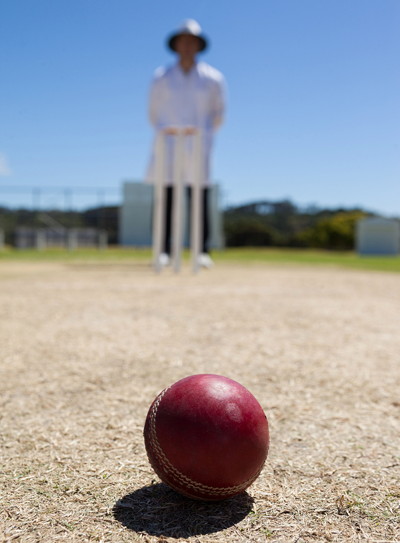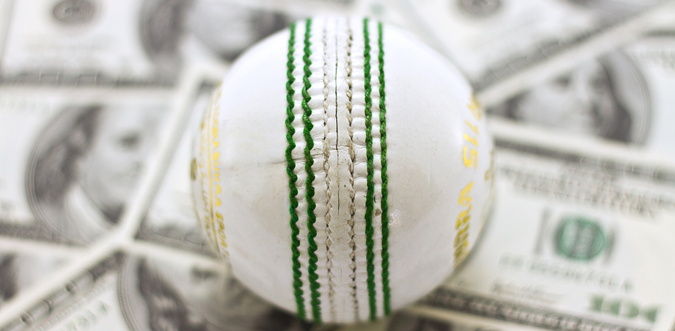Cricket Ball Tampering, What’s The Big Deal? Is It Cheating? What Happens To Your Bets?
 There are many arguments out there that suggest that it’s not actually that much of an issue if a bowler tampers with the ball in a cricket match. In recent years, virtually every change to the game of cricket has favoured the batsman. From limiting bouncers to putting restrictions on fielders, through to shorter boundaries and the front-foot no-ball rule, modern batsmen have it much easier than arguably any other time in the history of the game.
There are many arguments out there that suggest that it’s not actually that much of an issue if a bowler tampers with the ball in a cricket match. In recent years, virtually every change to the game of cricket has favoured the batsman. From limiting bouncers to putting restrictions on fielders, through to shorter boundaries and the front-foot no-ball rule, modern batsmen have it much easier than arguably any other time in the history of the game.
It wasn’t so long ago that the batsman could rub the ball on the actual wicket to scuff it, if they wanted to do so. Yet now we’ve entered an era when even throwing the ball on the bounce causes issues and handwringing for those that are in change of the sport. There has been a crackdown on any sort of ‘roughing up’ of the ball and perhaps only the Umpire Decision Review System is a way of evening things out for the bowlers.
The entire subject came to the fore most prominently in March of 2018 when footage emerged of Australia’s opening bowler, Cameron Bancroft, using a ‘foreign object’ on the ball during the Third Test between the Aussies and South Africa. Whatever weight that the arguments suggested above might hold, the fact of the matter is that ball-tampering is against the rules of the game and players found guilty of it are punished.
What happens, though, if you’ve placed a bet on a match that it later transpires involved ball-tampering? Does anything happen to your bet? Whether it was a winning one or a losing one, there’s no question that the tampering done to the ball will likely have affected the outcome of the match. Bets that were winning ones might have turned out to be losers in other circumstances, whilst those placing losing bets could point to the ball-tampering as the reason that they didn’t win. Here’s a luck at the entire situation.
What Is Cricket Ball-Tampering?

There are many sports around the world that are popular enough for people to bet on them without having a particularly in-depth knowledge of the subject matter. How many people will likely place a bet on the World Cup every four years whilst studiously avoiding watching any football the rest of the time? The Grand National is known as the only horse race that punters place a bet on despite having no interest in horse racing the other three-hundred and sixty-five days of the year. If we’re going to have a look at ball-tampering as a subject, therefore, it’s only right to briefly explain exactly what it is and how if might affect the outcome of a cricket match.
Before talking about what ball-tampering is, it’s important to realise how a cricket ball works in general. Very simply, the ball can ‘swing’ through the air, creating a movement that makes it more difficult for the batsman to know what it is likely to do. There are essentially two types of swing, reverse and conventional. Starting with reverse swing, this is what happens when the ball moves towards a side that is drier than the other one. Conventional swing, on the other hand, moves towards a side of the ball that is heavier. The heaviness is usually brought about thanks to some sort of moisture being on that side.
There are basically three different types of ball-tampering. The first involves the use of something like a bottle-top to pick at the seam of the ball. The second involves ‘scuffing’ the side of the ball that the cricketers want to be dry. They might do this by rubbing the ball on a zip on their trousers, for example. Finally, a player might apply moisture to the ball by mixing their saliva with lip balm or suncream. It’s not unknown for bowlers to suck sweets in order to make the side of the ball they’d like to be heavier a little more sticky and therefore have more moisture attached to it.
There is a certain amount of ball-tampering that is actually legal. Players can rub the ball on their trouser leg, say, or they can dry it with a towel. They’re also allowed to remove any mud or dirt from the ball, but they’re not allowed to do that unsupervised. That’s why you’ll often see cricketers standing alongside the umpire as they inspect and make alterations to the ball.
It’s only when an outside object is involved that the ‘tampering’ shifts from being legal to being against the Laws of the Game. All of this is a brief and short explanation of a rather complicated topic, as it happens, but it’s important to realise what it is that we’re talking about in order to understand what we’re going on to discuss next.
Why Is Ball Tampering In Cricket So Controversial?
 In cricket, the movement of the ball is a crucial part of the game. The ball deteriorates as the game goes on, which is to be expected from something made of cork and wrapped in leather being thrown at speeds of close to one-hundred miles-per-hour. A new ball comes into play at the start of each innings, with the bowling team able to request a new ball after a given number of overs. At the moment that stands at eighty overs in Test cricket. If a ball is lost then it is replaced by one with a similar level of wear – that’s how influential the state of the ball can be in Test cricket.
In cricket, the movement of the ball is a crucial part of the game. The ball deteriorates as the game goes on, which is to be expected from something made of cork and wrapped in leather being thrown at speeds of close to one-hundred miles-per-hour. A new ball comes into play at the start of each innings, with the bowling team able to request a new ball after a given number of overs. At the moment that stands at eighty overs in Test cricket. If a ball is lost then it is replaced by one with a similar level of wear – that’s how influential the state of the ball can be in Test cricket.
Given that the ball is supposed to deteriorate naturally, you can see why the rubbing or otherwise illegal scuffing of a ball could have such an impact to the outcome of a match. Batsmen get used to the way that a ball moves as a match develops, changing their playing style along with the deterioration of the ball. If that deterioration was suddenly accelerated then it could easily throw a batsman off their game and they could be dismissed much earlier than in normal circumstances. That’s why it’s such a controversial topic, with former cricket Nasser Hussain suggesting that a team found guilty of ball-tampering will have all of their previous matches looked at with fresh eyes full of suspicion.
The interesting thing about ball-tampering as a topic, which was alluded to in the introduction, is that it’s quite similar to diving in football or taking a medical time-out in cricket; it’s morally questionable but not that serious an offence in the grand scheme of things. Indeed, the former cricketer David Lloyd believes that the ICC should be considering moving it from a Level 2 offence to the highest one in the ICC’s Code of Conduct, Level 4. The question for many in the sport is, is it as bad as the famous sledging that takes place during every Test match? It is treated far more seriously, yet should that be the case? That’s the place that cricket finds itself in at the moment.
What Happens To Bets When The Ball Is Tampered With?

From a betting point of view, of course, it’s a very serious thing to happen. As mentioned before, the entire direction of a cricket match can be altered because of ball-tampering, which in turn will affect the result of a bet on that cricket match. We don’t know how often ball-tampering goes on undetected, but when it is revealed to have happened does it make any difference to the way that the result of the match is viewed?
The short answer is ‘no’. Bookmakers view official results as the results that they will pay out on, regardless of the sport and regardless of what happens. Let’s look at football and a First Goalscorer bet as an easy example to explain what we’re talking about. If you placed a First Goalscorer bet and there was a question mark around the scorer of the first goal in a game, two players jumping and heading the ball at the same time, say, then a bookie will pay out according to the declaration of the goalscorer by the Press Association in the wake of the game. If the goal is then referred to the Dubious Goals Panel and it’s decided that it was the other player that scored it, it’s too late. The result as declared is the one that stands for betting purposes.
Things might seem slightly different when it comes to something like ball tampering, given that it’s essentially a low-grade form of cheating, but as far as bookmakers and bets are concerned the only thing that they’re interested in is what the official outcome of the match is. If you’d placed a bet on South Africa to win the Test and Australia won it because of ball-tampering, the latter part of that sentence isn’t taken into account according to the record books. A look on the Cricket Australia website doesn’t feature an asterisk (*) suggesting that the result is in some way marred or altered. As it happens, South Africa won the Test anyway, so the ball-tampering didn’t do the job that they wanted it to.
What Impact Did Ball Tampering Have in The Australia vs South Africa Test Match?
Whilst the bets might well stand as they are, there are still some things to think about in terms of betting moving forward. There might not be anything that can be done about your bets that will have already been settled, unless the match is called off or voided as a result, but if you’re thinking of placing more bets on the remainder of the Test then one thing you’ll want to think about is the mentality of both sides as the Test progresses.
Let’s have a look at the Test between South Africa and Australia in 2018 as the most obvious example of what we’re talking about. The controversy surrounding the ball-tampering happened on the third day of the Test, with things not exactly hanging in the balance but far form secure. The hosts had scored 311 all out, whilst Australia had managed to respond with 255 all out in the first innings. With only 56 runs in it, the entire Test was all to play for. At the end of Day Three, after everything had come out, Steve Smith and David Warner decided to step down as the Captain and Vice-Captain of the Australian team.
At that point, whether angered by what the Australians had done or because the Aussies were distracted by proceedings, South Africa went on to rack up another 373 all out, giving them a lead of 429 for the visitors to chase down. The Australians completely collapsed in their second innings, managing just 107 all out. All of which means that if you’re going to bet on a Test that contains some form of controversy then you’ll want to bear in mind how it might have affected the team found guilty of doing something that they know they shouldn’t.
It’s also interesting to note that in that instance the controversy carried over into the Fourth Test, with the South Africans managing 488 all out in their first innings and 344 for 6 before declaring in their second. The Aussies got 221 in their first innings and 119 in their second, demonstrating that the mental fatigue of such incidents can help bettors find the right option to go for in both the live and ante-post odds.



